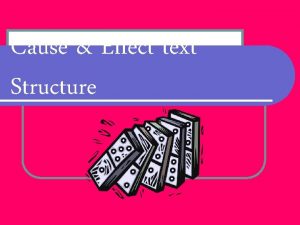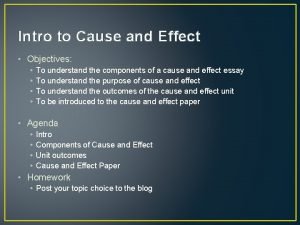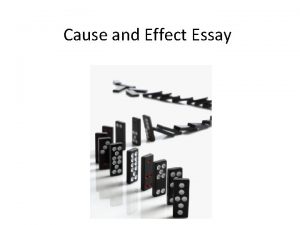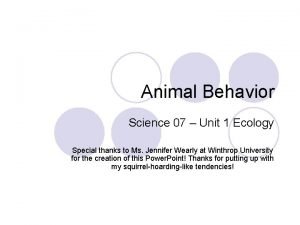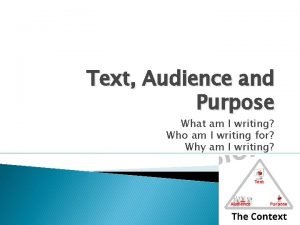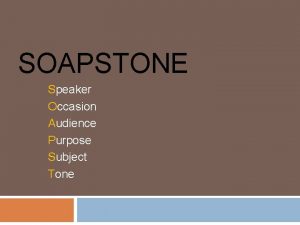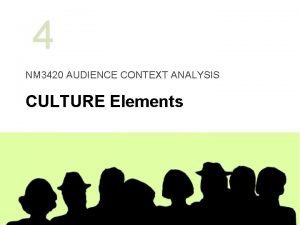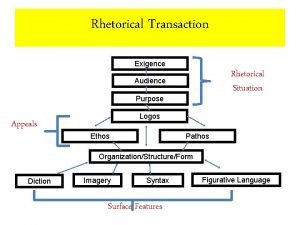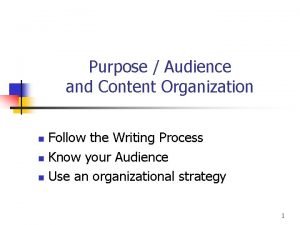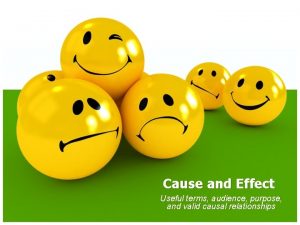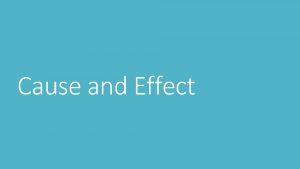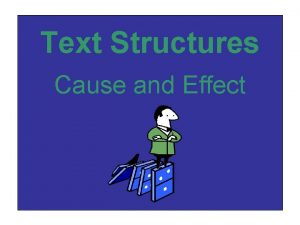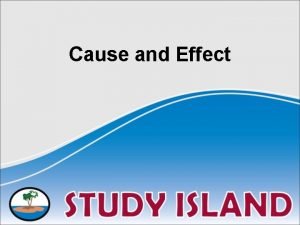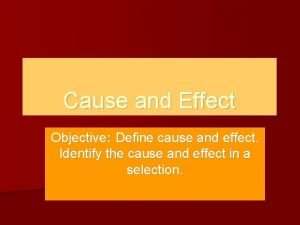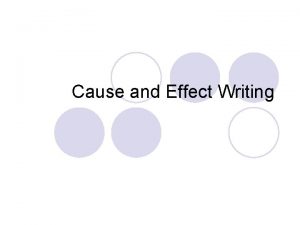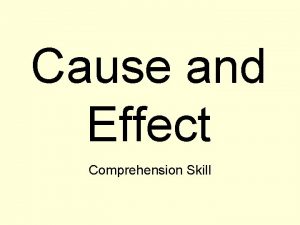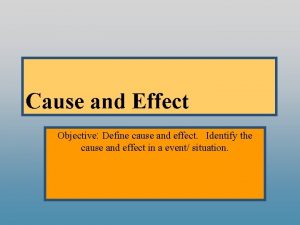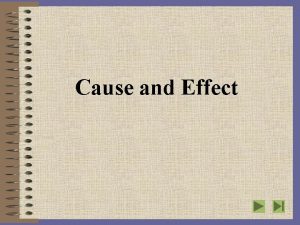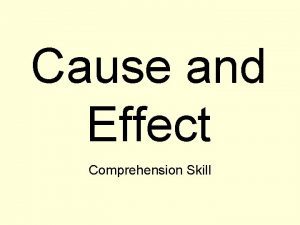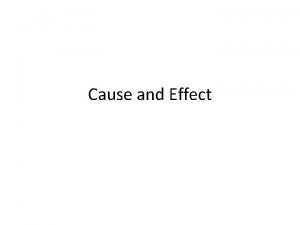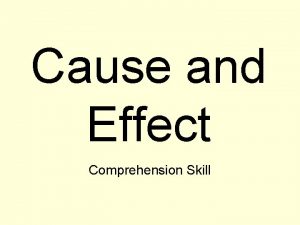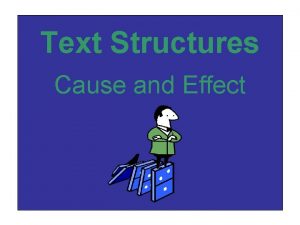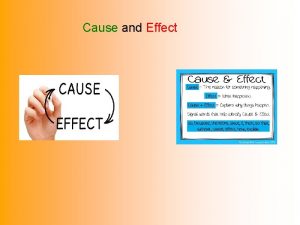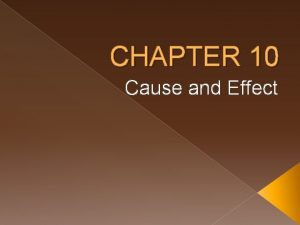Cause and Effect Useful terms audience purpose and




















- Slides: 20

Cause and Effect Useful terms, audience, purpose, and valid causal relationships

CAUSE AND EFFECT ESSAY • An examination of a topic to discover, explain, or argue why a particular action, event, situation, or condition occurred.

CAUSAL RELATIONSHIP • The events of one sort (the causes) are systematically related to the events of some other sort (effects).

TEMPORAL RELATIONSHIP • Two or more events related by time rather than anything else.

LOGICAL FALLACY • An error in reasoning.

POST HOC REASONING • Reaching a conclusion without any evidence at all. • Where people mistake a mere coincidence for a cause-and-effect relationship. • They see that A happened before B, so they mistakenly assume that A caused B.

POST HOC FALLACY: example Suppose you see a man in a black jacket hurry into a bank. You notice that he is nervously clutching his briefcase, and a few minutes later you hear a siren. You leap to the conclusion that the man in the sinister black jacket has robbed the bank.

More examples… • Joan is scratched by a cat while visiting her friend. Two days later she comes down with a fever. Joan concludes that the cat’s scratch must be the cause of her illness. • I had been doing pretty poorly this season. Then my girlfriend gave me this neon lace for my spikes and I won my next three races. Those laces must be good luck…if I keep wearing them, I can’t help but win!

PRIMARY CAUSE vs. Secondary Cause The Primary Cause is the central reason for something… The Secondary Cause is a supporting reason for something…

Causal Analysis • • • Process of asking, “Why? ” To determine a cause for an effect Why did this take place? What are the effects of such an act or statement? An evaluation of the chain of events that leads to a particular occurrence

Example Let’s say that you have received an “A” on an English paper recently. You may wish to analyze your paper closely to determine why you received the A so that you will write similarly for the next assignment in the interest of earning the same grade. In this case, you are starting with an effect or result, an A paper, and you are seeking out the reasons or causes for it.

Reasons/Causes for an “A” Paper You knew the subject matter thoroughly before writing You outlined and organized the major points of the essay before writing You had an effective introductory paragraph You had excellent support for your main idea You revised each paragraph, clarifying each main point while paying attention to style and vocabulary You proofread the paper carefully You created an intriguing title for the paper

Causal Analysis • Causes and Effects • Effects

Creating a Cause/Effect Response 1. Present a reasonable thesis statement. It is unreasonable to expect a reader to believe a thesis statement which is highly exaggerated, over-simplified, or prejudiced. For instance, “Fluoridation in our nation’s water supply is a Communist plot” would not be a reasonable thesis statement; it might bring a smirk to your reader’s lips, but it will not bring credibility to your paper.

Creating a Cause/Effect Response 2. Limit your discussion to major causes and/or effects. Although you may acknowledge minor causes and/or effects, you should spend most of your essay discussing major issues. As an example, the Confederacy’s firing on Fort Sumter was a direct cause of the American Civil War, but it was not as important an issue as secession or slavery.

Creating a Cause/Effect Response Oftentimes, one cause leads to another, which in turn leads to a chain reaction 3. Include all steps in your cause and effect relationship. Clearly explain each cause. Otherwise, your reader will be confused

Creating a Cause/Effect Response 4. Do not over-simplify causes and/or effects. Many subjects contain more than one cause or effect. Do not assign one blanket cause or effect to an obviously more complicated situation. For example, to say “I lost my job because the boss hates me” is to over-simplify the situation. If he does not like you, there are undoubtedly specific reasons for his feelings which led to your dismissal. It might prove helpful to outline several major causes and/or effects pertinent to your topic before you begin writing.

Creating a Cause/Effect Response Causal Analysis Writing Topics • Analyzing a success or failure • Effects of a family tradition • Causes for a superstition • Effects of a fear • Reasons for dislike • Causes for tardiness and the effects of tardiness

Causal-analysis notes (2010). www. sinclair. edu. Retrieved 13 October 2010.

Beginning Format • Definition of the Problem/Description of Event • Discussion of the causes • Possible Solutions/Effects • Works Cited Page (only if research is used)
 Cause and effect structure words
Cause and effect structure words Cause and effect purpose
Cause and effect purpose Cause and effect essay
Cause and effect essay Audience addressed audience invoked
Audience addressed audience invoked Polynomial degrees and terms
Polynomial degrees and terms Like terms in algebra
Like terms in algebra Genre and purpose
Genre and purpose Longest portion of a memorandum
Longest portion of a memorandum Speaker occasion audience purpose subject tone
Speaker occasion audience purpose subject tone Underlying cause and immediate cause
Underlying cause and immediate cause Greylag goose egg-retrieval behavior
Greylag goose egg-retrieval behavior Proximate causes vs ultimate causes
Proximate causes vs ultimate causes Proximate cause and ultimate cause
Proximate cause and ultimate cause Purpose audience language layout
Purpose audience language layout Text audience purpose
Text audience purpose What is tone in soapstone
What is tone in soapstone Genre audience purpose
Genre audience purpose Purpose audience context culture
Purpose audience context culture Subject soapstone
Subject soapstone Exigence definition literature
Exigence definition literature Content purpose audience strategy
Content purpose audience strategy
